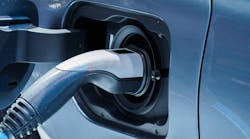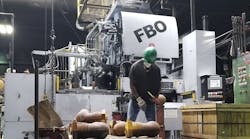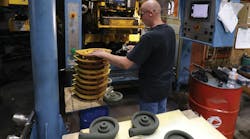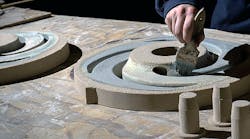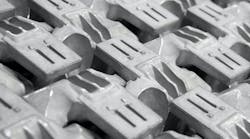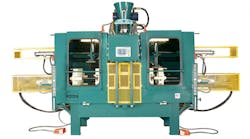Metalcasting facilities aiming to improve processes to maximize efficiency and profits often overlook the core room: historically, it’s been hard to get good ROI there because many new core machines are updated copies of what has been in place for a long time. Technology has not progressed. Some foundries found it necessary to switch from a hot process to cold-box coremaking to meet capacity demands. Although more productive, shorter-cycle times cold-box coremaking usually does not cut costs much, if at all.
Harrison Machine Co. saw why many core rooms were like a trip into the past: there is very little new technology available. HMC stopped building the “same old core machine,” and asked customers what the industry’s real coremaking issues are. There are many, the most common are productivity, quality, safety, inflexibility, unreliable machines, high maintenance and operating costs, and high labor requirements.
Harrison Machine recognizes there are advantages to both hot and cold process coremaking. Because it offers core machinery for both processes, it emphasizes that the best process for an individual foundry is the one that makes the best castings at the lowest cost. Thus, it has developed process and machine evaluation and comparison tools to help determine which process, machine, and accessories are best at meeting those criteria. It also developed new technology, Dual Station (hot and cold box) core machine models, to address each of the industry’s major coremaking issues:
Productivity has been increased in several ways. Most obvious is that HMC Dual Station machines run two jobs simultaneously, so one cycle produces cores from two core boxes in a little more than the time it takes to run one box. But, numerous foundries already using HMC Dual Station machines needed a faster process, so a new pneumatic actuation technology was introduced.
The new design will reduce process times by 25%, and HMC also increased the efficiency of the simultaneous operating systems by reducing in-process machine time to as little as 6 seconds of the total two-station cycle time. Then, changeovers/setups were simplified and reduced to as little as 7 minutes. Hot process heat sinks have all but eliminated temperature recovery time additions to cycle time. Cold process Smart Cure sensor feedback provides cycle optimization data. All together, the improvements increase average productivity by 200% over competing new machines, or 300-400% over existing old machines using existing tooling.
Core quality improvements result from a digital temperature control system in the hot process machines and the Smart Cure system in the cold process machines. Hot process machines will hold operating temperatures to +/-5°F and repeat a shell wall thickness tolerance as little as 0.007 in. Cold process Smart Cure systems reduce resin and catalyst usage, increase cure thoroughness, and reduce off-gassing significantly.
Process settings for several thousand boxes are stored in onboard non-volatile memory for quick recall and repeatable quality results. New blow technology improves core density; a hot process blow plate and head cooling system keeps blow holes open and sand flowing; separate, customizable quick-change blow hole inserts for each box, and separate blow pressure and time controls for each box, ensure repeatable fill. All these details help to reduce core scrap and result in fewer core-related casting defects and scrap.
Safety has been addressed with a continuous improvement program on a foundation of hard and dynamic guards, coupled with active monitors, interlocking switches, a full pneumatic power dump, and a full lock-out-tag-out system. Most important, HMC significantly reduced the operators’ level of participation in the coremaking process to just “start” and “unload cores” —which can be automated too, reducing operator involvement.
Flexibility is very important today, with demand for “just-in-time” operation and smaller quantities per setup. A single production station machine limits you to one job at a time; a multiple machine set-up requires more capital, and more operators.
HMC Dual Station machines provide flexibility for running both pieces of a two-part core at the same time and assembling while running. Or, it’s possible to schedule one long cycle and multiple short cycles on each station; a large core on one station and a multi-cavity small core box on the other; heat one box while running the other; change over one while the other is running; run two dissimilar blow-hole arrangement boxes; a long or continuous run on one station and short jobbing work on the other; or two of the same box for very high volume requirements, with additional capacity for other work. These are some of the operational possibilities with just one HMC Dual Station core machine.
In terms of reliability, the critical factoris to minimize downtime. HMC adopted “infinite life design” practices, where practical, and U.S.-made, commercially available components as much as possible. The approach is to reduce downtime with simple, robust designs suited for harsh foundry conditions, with locally available commercial parts, and indexable wear parts. HMC machines feature a network connection for factory diagnosis, on-board diagnostic screens, backed-up operating system and screens, and backed-up box setting programs. All these details contribute to higher utilization and lower maintenance requirements.
Operating Cost, which determines return on investment, is determined by overall cost-per-core. HMC Dual Station core machines achieve a fast and superior ROI because of two basic facts: fewer machines and shifts are required to meet demand, and cost-per-core is significantly lower. Fewer machines are required because of consistent higher productivity, repeatable run times, quick changeovers, higher utilization, and unmatched flexibility. Lower cost-per-core from lower investment cost, fewer shifts, less energy usage, lower maintenance requirements, lower parts cost, and reduced scrap: HMC’s new technology Dual Station core machines deliver practical innovations that provide cost-effective solutions to today’s coremaking issues in a reliable, foundry hardened package.
More information is available Harrison Machine Co. Visit www.harrisoncore.com

